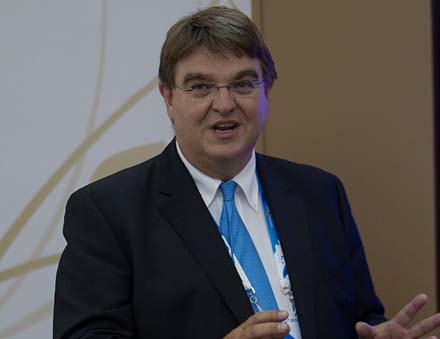Tennis Australia CIO beefs up Open IT

Tennis Australia chief information officer Chris Yates likens organising the chaos of the Australian Open to the job of an air traffic controller.

Tennis Australia CIO Chris Yates
(Credit: IBM)
Every day, there is a bevy of players who expect to face opponents: they need to know where to go. A draw needs to be developed that will see the right players playing on available courts at the right times.
Previously, this was done by hand, using "sticky notes up on a whiteboard with highlighter pen", according to Yates. Now, however, all information is fed into a scheduling system which defines the matrix of play, considering all the rules and constraints.
"These guys are running this like aircraft traffic controllers. If you think of each court as a landing strip, you've got people coming in. They've got to be played," he said.
All of the scoring done by people on the court using PDAs is fed into the scheduling system which then further defines the next level of the game.
"We actually call all of the scoring infrastructure the heartbeat of the game," he said. "The scheduling room is actually my favourite spot. It's like being on the main bridge in Star Trek," he said.
In order to run this — the coaches' demand for video analysis of play and the needs of the Open's website (8.6 million unique visitors came to the Open's website last year) — Yates had to put in the infrastructure, including a new upgraded server room running on IBM kit.
When Yates first started with Tennis Australia three years ago, six weeks before the Open, he saw that the organisation was doing an awful lot of set-up work to get the tournament up and running. He formulated a three-year plan and began to work with sponsor IBM on how to get more power out of the small amount of space he had in the Open.
"We're effectively land locked," he said.
He wanted also to make it scalable so that all he had to do was turn a dial to get what he needed. During the weeks of the Open, Tennis Australia's employees rise from 300 to 2000, making Melbourne park effectively a small city. This equipment also serves Tennis Australia's needs across Australia during the time the Open is not on, dealing with tournaments in other cities.
Upping the grunt and functionality of Tennis Australia's server room meant replacing old "deadbeat" IBM servers and investing $0.5 million in an upgrade based around IBM's XIV range, he said, with virtualisation playing a part. After two years the upgrade is near completion, although there are still some minor upgrades to be made.
Tennis Australia has been pleased with its new equipment, with Tennis Australia infrastructure manager Andrew Player saying, "We love it. It's awesome."
But the partnership might not have time to rest on its laurels, because there may soon be more space for another revamp. Now that the government has decided to spend hundreds of millions on an upgrade to the Open's home ground, it might free some space for the IT team — although getting the designers to remember IT in their plans has been a challenge, according to Yates.
"I keep designing this IT department which keeps getting smaller on the plans," he joked.
Suzanne Tindal travelled to the Open in Melbourne as a guest of IBM.